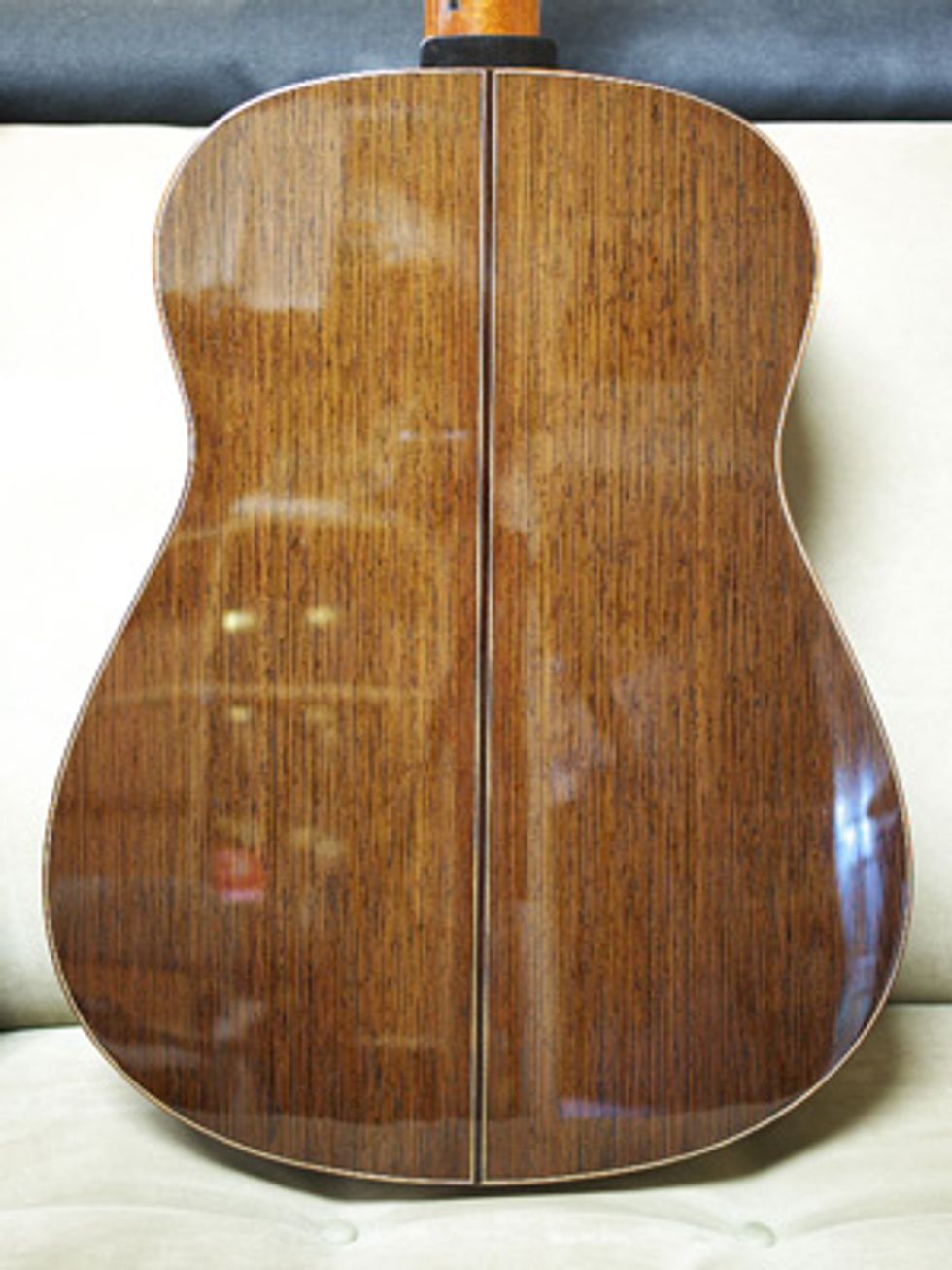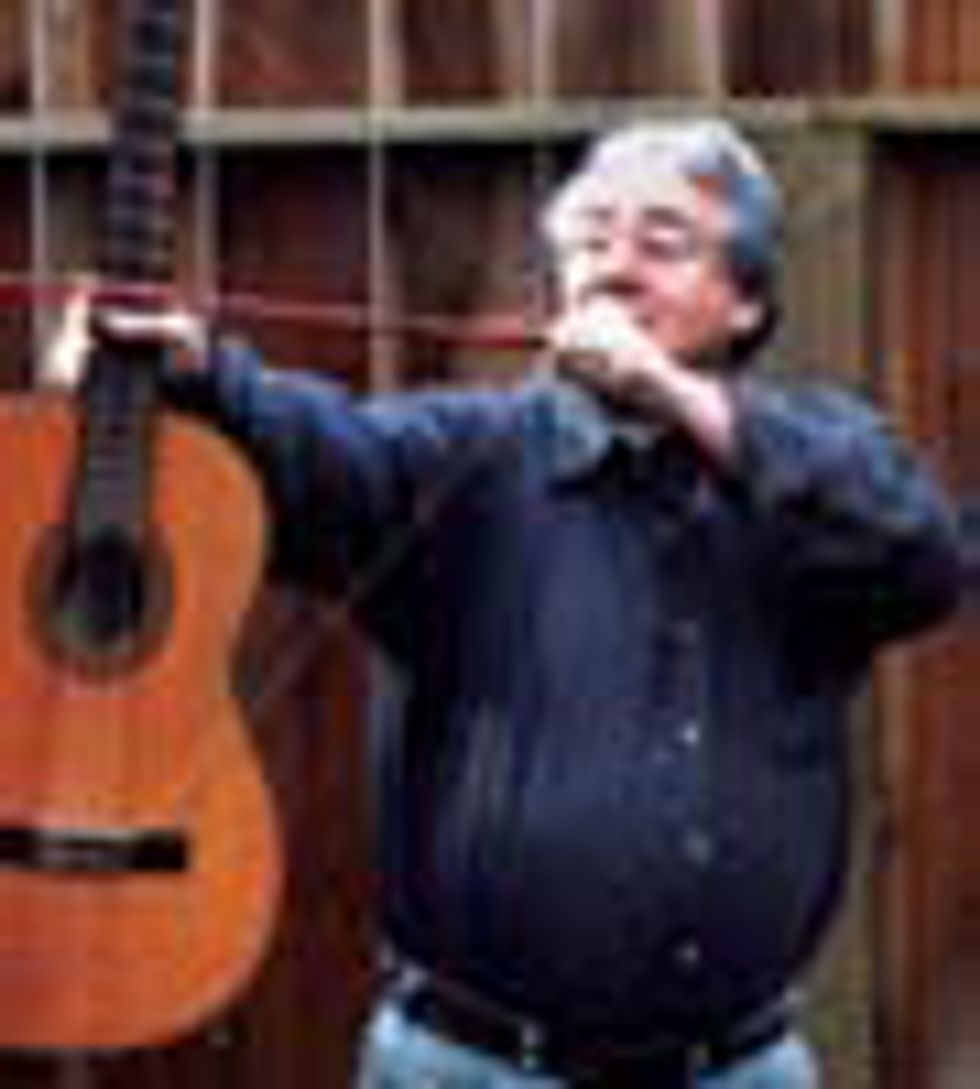
A very live African hardwood, wenge offers sonic qualities that make it a viable substitute for Brazilian rosewood. This steel-string has a two-piece wenge back.
Long considered the holy grail of guitar-making woods, Brazilian rosewood is getting scarce, expensive, and—with such legislation as the Lacey Act coming to the fore in recent years—illegal to have unless one has the proper paperwork that shows its age, provenance, and legality to be allowed to cross borders. It comes as no surprise that wood suppliers to the industry are now offering new and supposedly more sustainable woods for making guitars— some that no one had heard of 10 years ago or that come from countries half of us can’t find on the map. And all these woods, of course, are marketed as being desirable and adequate substitutes for traditional woods in terms of grain, figure, color, dimensional stability, price, etc.
In my view, some are adequate substitutes and some are not. As a guitar maker, I prefer woods that are “live,” regardless of their grain, figure, or color. What that means in practical terms is that one will be able to get a live and musical tone from a particular slice or chunk of wood when tapping on it. The reason some woods are called tonewoods is because they literally produce a musical note. And this quality, when used to make a guitar soundbox, will make a better and more acoustically active guitar than would be the case if the woods used made some kind of thud or thunk when tapped.
There are live woods that look rather plain, while there are “dead” woods that look like Raquel Welch in 3-D. Fine for making furniture, the flash and beauty of the latter have an obvious appeal, and many guitars get made simply because their visual gorgeousness will be a strong selling point. Fully as much to the point, when considerations of tone and appearance vie for customers, heated discussions about the benefits of this or that combination of materials will occur, and a variety of woods will be presented as being “as good as,” “acoustically responsive,” “high quality,” “surprisingly good,” “improved by patented methods of treatment,” “a comparable alternative,” “now used by the so-and-so factory for their higher-end guitars,” and so on.
My own searches have brought me to wenge (pronounced WHEN-gay). It’s a dark, purplish-brown-colored African hardwood that has long been used by bowl turners and cabinet/furniture makers. For some reason, not too many builders have thought about using it for guitars yet, so it’s still relatively cheap. The thing that appeals to me about wenge is that it is very live. When you hold a piece of it up and tap on it without damping any of its vibrational modes, it’ll ring like a piece of glass, plate of steel, or a crystal brandy snifter. This quality is known as vitreousness, which literally means glasslike-ness.
Wenge’s vitreousness is a function of the wood being brittle on the cellular-structure level. It’s that very brittleness that makes the vibrational action and the sound that it produces possible. With that, the brittleness that is a plus for sound has a mechanical downside, in that the wood cracks easily if it’s mishandled (just like glass), and gives one splinters if one is careless with it. It can also take more patience to bend, because brittle woods simply don’t want to bend easily.
However, it’s this very potential for cracking that puts wenge in the same category as the aforementioned most-prized of traditional guitar-making woods. As lovely, alluring, and live that Brazilian rosewood is, it has also earned a reputation for being subject to cracking. Sound versus fragility: It’s a tradeoff for which there are few solutions, so long as one wishes to use that material. The solutions involve either overbuilding to minimize fragility (which comes at the expense of tonal response), or mindful treatment and care in the making, in the handling, and in the using (which may give you structural fragility, but much more sound).
Though the acoustic properties of a given wood might make it a joy for a guitar maker to work with, marketing a new wood can be tricky. No one will have heard of it—much less have had experience with it—so the buying public will probably be resistant to accepting it.
That said, making guitars with wenge for the back and sides should not be much of an impediment for younger guitar makers who are still establishing their reputations and styles. It’s the more established guitar makers like myself who meet the greatest resistance to anything new, since we already have reputations for using this wood or that wood, or have a familiar style or feature associated with our work.
In my case in particular, everyone wants me to make the same thing I’ve been making for my other clients, with the traditional woods and designs. After all, they have good track records. I’ve made five guitars using wenge so far, and am working on my sixth, but most of my customers still want Brazilian rosewood. That’s fine, but wenge is a really good alternative for anyone who is willing to be open-minded. And it makes the guitars less expensive. All wenge needs is a good advertising campaign behind it.
 Ervin Somogyi
Ervin SomogyiA professional luthier since the early 1970s, Ervin Somogyi is one of the world’s most respected acoustic-guitar builders and rosette designers. To learn more about Somogyi, his instruments, or his rosette and inlay artwork, visit esomogyi.com.










![Rig Rundown: Russian Circles’ Mike Sullivan [2025]](https://www.premierguitar.com/media-library/youtube.jpg?id=62303631&width=1245&height=700&quality=70&coordinates=0%2C0%2C0%2C0)






